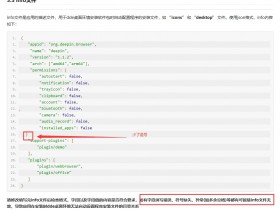- A+
在WPF中,所有继承自FrameworkElement的元素都包含一个Resources属性,这个属性就是我们这篇要讲的资源。
这一篇讲解的资源是不是上一篇的程序集资源(那个是在编译过程中打包到程序集中),这个是资源是我们想在公共的地方写一个对象让其他元素重复使用。
先贴个例子:
<Window x:Class="NETResource.MainWindow" xmlns="http://schemas.microsoft.com/winfx/2006/xaml/presentation" xmlns:x="http://schemas.microsoft.com/winfx/2006/xaml" xmlns:d="http://schemas.microsoft.com/expression/blend/2008" xmlns:mc="http://schemas.openxmlformats.org/markup-compatibility/2006" xmlns:local="clr-namespace:NETResource"0 mc:Ignorable="d" Title="MainWindow" Height="450" Width="800"> <Window.Resources> <SolidColorBrush x:Key="RedBrushButtonBackground" Color="Red" /> </Window.Resources> <Grid> <Grid.Resources> <SolidColorBrush x:Key="BlueBrushButtonBackground" Color="Blue"/> </Grid.Resources> <StackPanel> <Button Width="120" Background="{StaticResource RedBrushButtonBackground}" Content="我是按钮A"/> <Button Width="120" Background="{StaticResource BlueBrushButtonBackground}" Content="我是按钮B"/> </StackPanel> </Grid> </Window>
显示效果:
从例子中我们看几个资源的关键点,我们再Window元素和Grid元素下添加两个颜色画刷资源,使用x:key标识。上面2个Button都使用了2个不同层级的父元素资源。WPF中有个设计比较好的地方就是元素可以使用父元素的资源。这样我们都把资源放在Window节点下,公用这些资源。
资源定义好之后,再使用时,可以指定以静态的方式使用资源,还是以动态的方式使用资源。
差别就是静态资源只从资源集合获取对象一次,对象的任何变化都会得到消息,而动态资源每次需要用到对象时都会重新从资源集合中查找对象。注意动态资源是每次需要用到对象时才会去资源集合查找,所以在资源非常大,且非常复杂的时候,可以用动态资源的方式可以提高第一次加载窗口的速度(因为没有解析资源标记的过程),其他任何使用都不建议使用动态资源。使用数据绑定去实现。
<Window x:Class="NETResource.Window1" xmlns="http://schemas.microsoft.com/winfx/2006/xaml/presentation" xmlns:x="http://schemas.microsoft.com/winfx/2006/xaml" xmlns:d="http://schemas.microsoft.com/expression/blend/2008" xmlns:mc="http://schemas.openxmlformats.org/markup-compatibility/2006" xmlns:local="clr-namespace:NETResource" mc:Ignorable="d" Title="Window1" Height="450" Width="800"> <Window.Resources> <SolidColorBrush x:Key="ButtonBrushBackground" Color="DarkBlue"/> </Window.Resources> <Grid> <StackPanel Width="120"> <Button Content="按钮A静态资源" Background="{StaticResource ButtonBrushBackground}"/> <Button Content="按钮B动态资源" Background="{DynamicResource ButtonBrushBackground}"/> <Button Content="点击切换资源对象" Click="SetButtonBackgroudButton"/> <Button Content="点击修改资源的值" Click="UpdataButtonBackgroundButton"/> </StackPanel> </Grid> </Window>
using System.Windows; using System.Windows.Media; namespace NETResource { /// <summary> /// Window1.xaml 的交互逻辑 /// </summary> public partial class Window1 : Window { public Window1() { InitializeComponent(); } private void SetButtonBackgroudButton(object sender, RoutedEventArgs e) { //修改资源指向的对象。只有动态资源会受到影响,因为动态资源每次使用值的时候,都会重新读取。静态资源不会,所以静态资源不受影响。 //修改样式1 SolidColorBrush solid = new SolidColorBrush(Colors.Red); solid.Opacity = 0.3; this.Resources["ButtonBrushBackground"] = solid; //修改样式2 // LinearGradientBrush linear = new LinearGradientBrush(Colors.Red, Colors.Blue, 90.0); // this.Resources["ButtonBrushBackground"] = linear; } private void UpdataButtonBackgroundButton(object sender, RoutedEventArgs e) { //修改资源对象的值,资源没有改变,只是改变了资源的值,所以2个按钮都受到影响。 var brush = this.Resources["ButtonBrushBackground"]; if (brush is SolidColorBrush) { ((SolidColorBrush)brush).Color = Colors.LightBlue; } } } }
如果有些资源是所有窗体都共享的,建议写在Application的.Resources下。
<Application x:Class="NETResource.App" xmlns="http://schemas.microsoft.com/winfx/2006/xaml/presentation" xmlns:x="http://schemas.microsoft.com/winfx/2006/xaml" xmlns:local="clr-namespace:NETResource" StartupUri="Window1.xaml"> <Application.Resources> <SolidColorBrush x:Key="TitleBrush" Color="Red"/> </Application.Resources> </Application>
<Window x:Class="NETResource.Window1" xmlns="http://schemas.microsoft.com/winfx/2006/xaml/presentation" xmlns:x="http://schemas.microsoft.com/winfx/2006/xaml" xmlns:d="http://schemas.microsoft.com/expression/blend/2008" xmlns:mc="http://schemas.openxmlformats.org/markup-compatibility/2006" xmlns:local="clr-namespace:NETResource" mc:Ignorable="d" Title="WPF教程九:理解WPF中的资源" Height="450" Width="800"> <Window.Resources> <SolidColorBrush x:Key="ButtonBrushBackground" Color="DarkBlue"/> </Window.Resources> <Grid> <TextBlock Text="WPF教程九:理解WPF中的资源" Foreground="{StaticResource TitleBrush}"/> </Grid> </Window>
资源我们都会使用了,接下来需要归类整理我们的资源,使用资源字典:
我们在工程上右键=》添加=》资源字典=》设置名字为AppBrushes.xaml=》保存
添加代码如下:
<ResourceDictionary xmlns="http://schemas.microsoft.com/winfx/2006/xaml/presentation" xmlns:x="http://schemas.microsoft.com/winfx/2006/xaml" xmlns:local="clr-namespace:NETResource"> <SolidColorBrush x:Key="DictionaryTitleBrush" Color="Beige"/> </ResourceDictionary>
在App.xaml中添加对资源字典的使用:
<Application x:Class="NETResource.App" xmlns="http://schemas.microsoft.com/winfx/2006/xaml/presentation" xmlns:x="http://schemas.microsoft.com/winfx/2006/xaml" xmlns:local="clr-namespace:NETResource" StartupUri="Window1.xaml"> <Application.Resources> <ResourceDictionary> <ResourceDictionary.MergedDictionaries> <ResourceDictionary Source="AppBrushes.xaml"/> </ResourceDictionary.MergedDictionaries> <SolidColorBrush x:Key="TitleBrush" Color="Red"/> </ResourceDictionary> </Application.Resources> </Application>
这样资源字典就可以被访问了。
我们创建一个button按钮使用资源字典内的样式
<Button Content="使用资源字典下的画刷" Background="{StaticResource DictionaryTitleBrush}"/>
这里有一个小技巧:我们还记得上一章讲的程序集资源,我们作为二进制存放我们需要保存的文件。那么我们创建的这个资源字典也属于文件,也可以被编译在程序集内,程序集资源又有BAML和Resources资源。BAML是编译后的,Resources是保持当前状态被嵌入到程序里面的。所以我们把资源字典的属性设置为page,会减少一个运行时解析过程。
跨程序集使用资源:这个可程序集资源的跨程序集使用。
一定要分清楚,什么是二进制资源(程序集资源持久化),什么是对象资源(公共部分重复使用的对象)。我们手动创建引用其他库的资源字典。
在新建资源DLL的时候,我没有找到直接新建添加引用之后的类库,所以我用以下2种方法种的一种来创建程序集,我使用的是第一种:
1)创建WPF程序,然后删除他下面的App.config、App.xaml、MainWindow.xaml 和Properties下的Rsources.resx、Settings.settings,工程右键=》属性=》应用程序=》输出类型=》类库。用于保留自动对PresentationCore、PresentationFramlework、WindowsBase的引用。
2)添加类库程序,然后添加=》引用=》PresentationCore、PresentationFramlework、WindowsBase。这三个的引用。
添加DLL完毕后,在窗体程序中添加对DLL库的引用。整个目录引用关系结构如下:

现在开始写代码,
首先是ResourceLibrary库。这个是我们的资源库,里面存放我们的资源文件。目前是一个xaml的资源字典。需要我们新建出来。
代码如下:
<ResourceDictionary xmlns="http://schemas.microsoft.com/winfx/2006/xaml/presentation" xmlns:x="http://schemas.microsoft.com/winfx/2006/xaml" xmlns:local="clr-namespace:ResourceLibrary"> <SolidColorBrush x:Key="ReusableTitle" Color="Yellow"/> </ResourceDictionary>
而后是引用的App,在App.xaml下添加跨程序集的资源字典(使用pack: URI):
<Application x:Class="WPFUsingResourceLib.App" xmlns="http://schemas.microsoft.com/winfx/2006/xaml/presentation" xmlns:x="http://schemas.microsoft.com/winfx/2006/xaml" xmlns:local="clr-namespace:WPFUsingResourceLib" StartupUri="MainWindow.xaml"> <Application.Resources> <ResourceDictionary> <ResourceDictionary.MergedDictionaries> <ResourceDictionary Source="pack://application:,,,/ResourceLibrary;component/ReusableDictionary.xaml"/> </ResourceDictionary.MergedDictionaries> </ResourceDictionary> </Application.Resources> </Application>
在Window窗体中使用以添加引用的资源:
<Window x:Class="WPFUsingResourceLib.MainWindow" xmlns="http://schemas.microsoft.com/winfx/2006/xaml/presentation" xmlns:x="http://schemas.microsoft.com/winfx/2006/xaml" xmlns:d="http://schemas.microsoft.com/expression/blend/2008" xmlns:mc="http://schemas.openxmlformats.org/markup-compatibility/2006" xmlns:local="clr-namespace:WPFUsingResourceLib" mc:Ignorable="d" Title="MainWindow" Height="450" Width="800"> <Grid> <Button VerticalAlignment="Top" HorizontalAlignment="Left" Width="180" Height="30" Content="我是跨程序集使用资源" Background="{StaticResource ReusableTitle}"/> </Grid> </Window>
效果图如下:

好啦,这一篇就写这么多把。主要是就是对象资源的使用,静态和动态资源的差别,跨程序集资源,元素可以使用父类资源。这篇主要是理解就行,后面会写软件,用于演示如何更好的使用这些内容。



